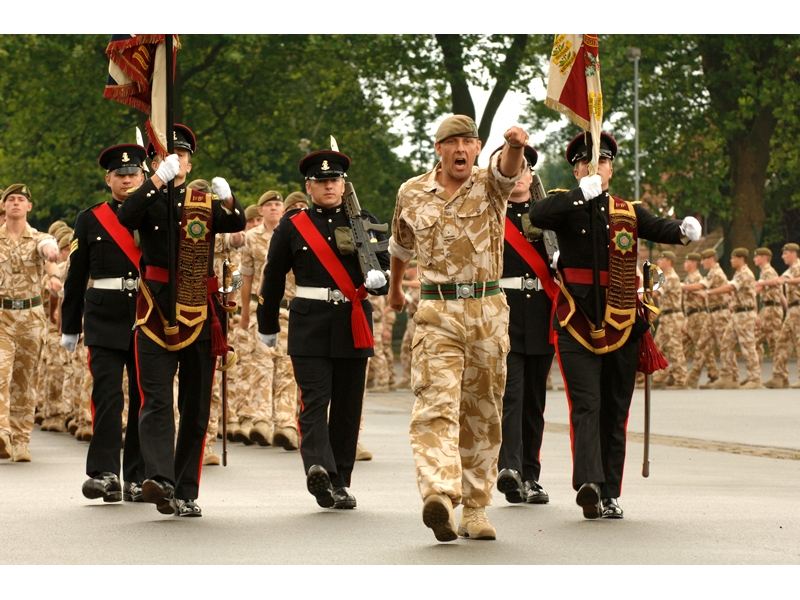
The Royal Yorkshire Regiment (RYORKS) is a distinguished infantry regiment of the British Army, embodying the rich military traditions and heritage associated with the Yorkshire region. Formed on June 6, 2006, through the amalgamation of three historic regiments—the Prince of Wales’s Own Regiment of Yorkshire, the Green Howards, and the Duke of Wellington’s Regiment—the Royal Yorkshire Regiment carries forward a legacy of service, honor, and bravery.
Historical Background
The Royal Yorkshire Regiment was established as part of the British Army’s Future Army Structure program, aimed at creating more flexible and efficient units. The antecedent regiments each had a storied history, contributing to the combined legacy of the Royal Yorkshire Regiment.
- The Prince of Wales’s Own Regiment of Yorkshire: Formed in 1958, the regiment traced its origins to the amalgamation of the West Yorkshire Regiment (The Prince of Wales’s Own) and the East Yorkshire Regiment (The Duke of York’s Own). These regiments had distinguished records of service, including significant roles in the Napoleonic Wars, both World Wars, and numerous colonial campaigns.
- The Green Howards (Alexandra, Princess of Wales’s Own Yorkshire Regiment): Established in 1688, the Green Howards earned a reputation for their bravery and resilience in various conflicts, including the War of Spanish Succession, the Crimean War, and both World Wars.
- The Duke of Wellington’s Regiment (West Riding): Founded in 1702, this regiment was named after the famous Duke of Wellington and had a proud history, with notable service at the Battle of Waterloo and throughout the British Empire.
Structure and Organization
The Royal Yorkshire Regiment is composed of both regular and reserve battalions, ensuring a versatile and comprehensive infantry capability.
Regular Battalions:
- 1st Battalion, The Royal Yorkshire Regiment (1 YORKS): Light infantry, specializing in rapid deployment and high-tempo operations.
- 2nd Battalion, The Royal Yorkshire Regiment (2 YORKS): Mechanized infantry, equipped with armored vehicles to enhance mobility and protection.
- 3rd Battalion, The Royal Yorkshire Regiment (3 YORKS): Armored infantry, using Warrior infantry fighting vehicles for frontline combat roles.
Reserve Battalions:
- 4th Battalion, The Royal Yorkshire Regiment (4 YORKS): Army Reserve battalion, providing additional manpower and expertise to support regular units.
- 5th Battalion, The Royal Yorkshire Regiment (5 YORKS): Similar to 4 YORKS, focused on supporting operations and training.
Operational Role
The Royal Yorkshire Regiment is trained for a wide range of military operations, reflecting its diverse capabilities:
- Infantry Operations: Engaging in direct combat, securing key positions, and providing security in various environments.
- Rapid Deployment: Capable of quick deployment to respond to emerging threats and crises.
- Peacekeeping: Participating in international peacekeeping missions, contributing to stability and security in conflict zones.
- Humanitarian Assistance: Providing aid and support during natural disasters and humanitarian crises.
- Training and Advisory: Assisting in the training and development of foreign military forces.
Notable Deployments
Since its formation, The Royal Yorkshire Regiment has been involved in numerous significant deployments:
- Iraq (Operation Telic): Participated in the invasion and subsequent stabilization efforts in Iraq.
- Afghanistan (Operation Herrick): Served in Helmand Province, contributing to counter-insurgency operations and training Afghan security forces.
- Balkans: Involved in peacekeeping operations in Bosnia and Kosovo, helping to maintain stability in the region.
- Estonia: Part of NATO’s Enhanced Forward Presence, contributing to the deterrence and defense posture in Eastern Europe.
Traditions and Culture
The Royal Yorkshire Regiment maintains a strong sense of tradition, drawing on its historical roots while fostering a modern regimental culture:
- Motto: “Fortune Favours the Bold,” reflecting their courage and initiative in operations.
- Cap Badge: Features the White Rose of Yorkshire, symbolizing their regional heritage and pride.
- Regimental Marches: “On Ilkla Moor Baht ‘at” and “Yorkshire Lass,” showcasing their connection to Yorkshire’s cultural heritage.
- Regimental Days: Celebrating significant historical events and battles from their antecedent regiments.
- Regimental Museum: The Royal Yorkshire Regiment maintains a museum showcasing its history, including artifacts, uniforms, and records of past service.
Modern Role and Adaptability
The Royal Yorkshire Regiment continues to evolve to meet the demands of contemporary military operations. Their adaptability ensures they remain capable of responding to a wide range of scenarios, from high-intensity conflict to peacekeeping and humanitarian missions. Continuous investment in training, equipment, and personnel development keeps the regiment at the forefront of the British Army’s operational capabilities.
Conclusion
The Royal Yorkshire Regiment embodies the enduring legacy of Yorkshire’s military history, combining historical traditions with modern military effectiveness. As a versatile and capable regiment, they continue to serve with distinction in various operational theatres, upholding their motto “Fortune Favours the Bold.” The Royal Yorkshire Regiment remains a vital and respected component of the British Army, demonstrating versatility, courage, and excellence in all their endeavors.